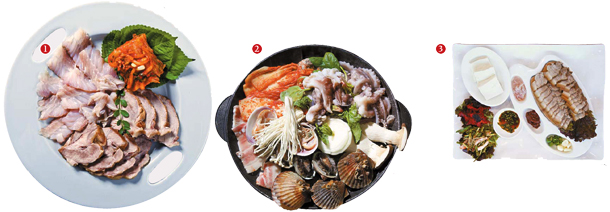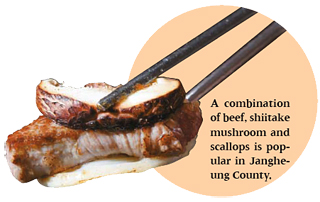Distinct regional flavors highlighted in samhap : Local culture reflected in unique mixtures of provincial ingredients

1. Hongeo samhap, a combination of three ingredients of fermented fish, steamed pork and kimchi, originates from the southern part of Korea, especially in Jeolla provinces. 2. Locals in Yeosu have developed a combination of local clams, steamed pork and kimchi as their major dish. 3. Gangneung in Gangwon has included tofu into making samhap with steamed pork and raw fish marinated in spicy sauce. [JOONGANG ILBO]
Samhap is usually a combination of meat, vegetables and seafood available in each region so that diners can enjoy different textures in one bite. All of the ingredients are usually cooked in the same pan or pot and diners are encouraged to put small pieces together so that they can chew all of the ingredients at the same time.
The most famous example of samhap is found in Jeolla province, known for its fermented fish called hongeo. Hongeo is accompanied with steamed pork and kimchi so that diners can make their bite more savory. Although the taste of fermented fish combined with other ingredients is not for everyone, it has become known as the representative dish of southern Korea and many visitors at least try a taste to see what it is like. When combined with the other two ingredients to ease the pungent taste of the fermented fish, diners find a combination of flavors that is the distinct taste of the region.
Hongeo is usually fermented for up to 10 days at the longest in a refrigerator kept between 5 and 10 degrees Celsius (41-50 degrees Fahrenheit). Steamed pork used to accompany hongeo is usually made with fatty pork belly or pork neck meat.
“Since hongeo and kimchi are both fermented, it has lots of enzymes to help people digest,” said Kim Hyeong-suk, an adjunct professor of nutrition at Hanyang University. “So adding steamed pork belly makes the overall dish not only nutritionally balanced but also taste good.”
The origin of fermented hongeo is often considered to be Yeongsanpo in Naju City, South Jeolla. In Yeongsanpo, there is Hongeo Street where around 40 stores and restaurants specialized in serving the particular dish line the road. About 1,500 tons of fermented hongeo is sold here each year. It costs about 80,000 won ($71) to have the combo dish, made with fish caught near Heuksan Island, that feeds between two and three diners, while it is a bit cheaper with fish from overseas. A hongeo dish made with fish from Argentina costs 25,000 won for two.

4. Samhap with octopus is often consumed in the eastern region of Korea including Sokcho, Gangwon. One eats it with steamed pork and raw fish marinated in a spicy sauce and can also dip the combo into many other sauces or cover it with seaweed or other vegetables. 5. Jangheung County in South Jeolla is known for its version containing beef, shiitake mushrooms and scallops. [JOONGANG ILBO]
In the nearby Yeosu, south Jeolla, a type of mollusk called a cockle is the main element in another famous taste combination. Yeosu fishermen used to combine unsold cockles with pork and kimchi and ate them together as a delicious treat. The dish has been one of the most popular choices in the area as it comes with a variety of seafood including abalone, octopus and scallops.
Pork, abalone and scallops should be grilled first and when the juices come out, the rest of the ingredients should be mixed together on the hot pan. Usually a big bowl of this combo for two to three people costs 100,000 won.

A combination of beef, shiitake mushroom and scallops is popular in Jangheung County.
People on the east coast of the country also add their own variety to the world of samhap. Gangneung in Gangwon, whose Chodang area is known for its tofu made with seawater, has created a combination with tofu on top of steamed pork and raw fish marinated in spicy sauce. Nearby Sokcho uses octopus which has been considered a special treat for locals. Since it cannot be farmed in the ocean and it is considered difficult to catch, octopus is usually reserved for weddings or ancestry rituals.
A whole octopus is usually served with steamed pork and raw fish marinated in spicy sauce. The combination can also be consumed with a seaweed called miyeok. Other side dishes like fermented sauces and condiments are added for flavor. However, this particular type of combo might not be available everyday, since it is prohibited to hunt octopus in an effort to preserve future production. Usually the combo with octopus costs 70,000 won and serves three to four people.
BY HONG JI-YEON [summerlee@joongang.co.kr]
음식에도 궁합 … 보기만 해도 즐거운 ‘삼합’
삼색 재료의 오묘한 조화
음식에도 시너지 효과가 있다. 각각 보면 평범한 음식인데 한 데 뭉쳐 먹으니 색다른 맛을 내는 독특한 메뉴가 된다. 삼합(三合)이 그렇다. 삼합의 사전적 의미는 ‘세 가지가 잘 어울려 딱 들어맞는다’는 뜻. 그러니까 세 가지 음식이 어울려 최상의 맛을 내는 것이 삼합요리다. 남도의 홍어삼합이 가장 유명하지만 찾아보면 전국 각지에 ‘○○삼합’이라 불리는 음식이 여럿 있다. 강원도 속초의 ‘문어삼합’은 예부터 제사상에 올린 귀한 음식이었고, 부산의 ‘갈미조개삼합’은 장기간 바다에서 시달렸던 어부들의 기력을 보해주는 특식이었다. 그런가하면 장흥의 한우삼합은 지역 특산품을 고루 맛보도록 의도적으로 개발한 메뉴다. 유래와 역사는 서로 다르지만 공통점이 있다. 식감과 맛이 서로 다른 재료가 모여 새로운 맛을 창조한다는 것. 전국 각지의 소문난 삼합요리를 소개한다.
삼합의 원조 - 홍어삼합
삭힌 홍어와 돼지고기 수육, 묵은 김치를 같이 먹는 홍어삼합은 전라도를 대표하는 향토음식이다. 십여 년 전 만해도 홍어는 전라도만의 별미였지만 지금은 전국 각지에서 홍어삼합을 먹는다.
홍어는 5∼10℃로 유지되는 냉장고에서 짧게는 일주일, 길게는 10일 정도 삭힌 것을 낸다. 수육은 비계가 붙어 있는 삼겹살이나 목살 부위를 주로 사용한다. 김현숙 한양대 식품영양학과 겸임교수는 “삭힌 홍어와 묵은 김치 모두 발효된 것이라 소화효소가 풍부하다”며 “여기에 동물성 단백질이 풍부한 삼겹살 수육을 곁들이는 홍어삼합은 영양학적으로나 맛으로나 균형이 잘 잡힌 훌륭한 음식”이라고 극찬했다. 홍어삼합을 입에 넣으면 먼저 묵은 김치의 시큼한 맛이 퍼져 침샘을 마구 자극한다. 꼬독꼬독한 홍어와 부드러운 수육, 서로 정반대의 식감을 지닌 재료들은 처음에는 각각의 맛을 강하게 내더니 씹을수록 조화를 이뤄 새로운 풍미를 만들어낸다.
전라도에서도 나주 영산포가 삭힌 홍어 주산지로 꼽힌다. 영산포에 가면 홍어 도매상과 전문 식당 40여 군데가 밀집한 ‘홍어의 거리’가 있다. 여기서 팔려나가는 삭힌 홍어가 연간 1500여 t에 달한다. 영산포홍어식당 아르헨티나산 홍어삼합 2인 2만5000원, 흑산도 산 홍어삼합 2~3인 8만원. 나주시 영산3길 6, 061-337-0020.
장흥 특산품을 한입에 - 한우삼합
전남 장흥에는 대표 특산품인 한우·키조개·표고버섯을 한 데 모아 먹는 한우삼합이 있다. 장흥 한우삼합은 역사가 짧은 편이다. 장흥군은 2005년 재래시장인 장흥장을 매주 토요일마다 여는 ‘토요시장’으로 탈바꿈시키며 일대에 한우 식당골목을 조성했다. 이때 전략적으로 육성한 먹거리가 한우삼합이다.
예부터 장흥은 ‘한우’로 이름났다. 장흥 인구는 4만 명에 불과하지만 군내에서 사육되는 한우는 6만 두에 달한다. 사람보다 소가 더 많은 고장이다. 장흥군은 표고버섯 주산지이기도 하다. 표고버섯의 전국 생산량 중 약 18%가 장흥에서 난다. 키조개는 장흥과 고흥 사이 득량만 해역에서 양식하는데, 1970~80년대 일본으로 전량 수출돼 비싼 값으로 팔리던 상품(上品)이다.
한우삼합은 이 어마어마한 먹거리 세 가지를 한 번에 모아 먹는 음식이다. 방법은 이렇다. 먼저 쇠고기를 올리고 키조개와 표고는 살짝만 굽는다. 그래야 키조개 관자 육즙과 표고향을 고스란히 살려낼 수 있다. 세 가지 재료를 모아 입속에 넣는 순간, 맨 먼저 쇠고기의 고소한 육즙이 온 입을 휘감는다. 그 뒤를 이어 쫄깃쫄깃한 키조개 관자의 담백함과 표고의 은은한 향이 어우러져 최상의 맛을 낸다. 장흥토요시장 안에 있는 ‘소몰고 불판으로’ 식당의 상차림 비용은 1인 3000원, 키조개·표고버섯(3~4인) 1만5000원, 꽃등심 1+ 등급 100g 8340원. 장흥군 장흥읍 토요시장2길 7, 061-864-8778.
겨울 별미 - 새조개삼합
‘명품 조개’라 불리는 새조개는 양식이 안 돼서 가격이 비싸다. 평균 가격은 1㎏ 4만원, 공급이 달릴 때는 1㎏에 7만~8만원까지 가격이 치솟는다. 제철은 12~3월. 여수에서는 3월이 지나면 새조개를 먹을 수 없다. 없어서 못 판다. 먹겠다는 사람이 하도 많아 쟁여놓을 새 없이 겨우내 전부 팔려나간다.
새조개삼합은 어민들이 만든 요리다. 여수 봉산동 식당 ‘천년의 바다’ 이운용 사장은 “상품성이 떨어지는 새조개를 돼지고기·묵은 김치와 함께 구워먹은 것에서 시작했는데, 지금은 다양한 해산물을 같이 구워낸다”고 말했다. 천년의 바다에선 전복·낙지·개조개·가리비 등 각종 갯것과 팽이버섯·시금치 등 채소를 푸짐하게 곁들인다.
오목한 불판에 가리비·전복·삼겹살을 먼저 굽는다. 삼겹살 기름과 조개에서 흘러나온 육수가 자작해지면 새조개와 나머지 재료들을 올린다. 새조개는 오래 구우면 수분이 전부 빠져 짠 맛이 강해지므로 살짝만 익힌다. 삼겹살·새조개·묵은 김치를 한꺼번에 입에 넣었다. 온갖 재료에서 흘러나온 육수가 범벅돼 새로운 맛이 났다. 삼겹살을 씹는데 바다 맛이 나고 새조개에선 향긋한 시금치 향이 배어났다. 쫄깃쫄깃한 낙지와 푹 익은 묵은 김치 등 다양한 재료를 새조개와 조합할 때마다 약간씩 다른 맛이 나서 먹는 재미가 쏠쏠했다. 천년의 바다 새조개삼합 2~3인 10만원. 여수시 봉산 남3길, 061-644-3010.
강원도의 맛 - 두부삼합
강릉시 초당동은 두부로 이름난 마을이다. 초당두부의 역사는 허균·난설헌의 아버지 허엽(1517~80)이 삼척부사로 부임했던 조선 후기로 거슬러 올라간다. 허엽은 마을 주민에게 해수로 두부를 빚으라 했고, 그 맛이 좋기로 소문나자 두부에 자신의 호 초당(草堂)을 붙였다. 초당두부가 전국적인 명성을 얻게 된 것은 1990년대 강릉이 휴양지로 인기를 끌면서부터다. 초당동 인근 경포해변에 관광객이 몰리자 그 즈음 초당동 두부 전문 음식점이 생겼다. 현재 면적 2.88㎢에 불과한 동네 안에 두부 전문 음식점 21곳이 있다.
초당두부 하면 순두부를 떠올리지만 초당동에서 맛볼 수 있는 이색 두부 요리도 있다. ‘초당면옥’이 만드는 두부삼합(2만5000원)이다. 초당동에서 나고 자란 정은숙 사장이 강릉시청과 공동으로 2016년 개발했는데 손님 둘에 한 명은 이 메뉴를 찾는다.
두부삼합은 담담한 두부, 고소한 돼지고기 수육에 매큼한 이북식 젓갈 가자미식해를 곁들인다. 두부는 입 안에서 부드럽게 부서지고, 쫀득쫀득한 가자미식해는 씹는 맛을 더한다. 여기에 고소한 수육 맛이 어우러진다. 정 사장은 이틀에 한 번 꼴로 두부와 식해를 직접 만든다. 강원도 삼척(콩), 속초·강릉(가자미)에서 난 식재료를 고집하는 것도 이 집의 장점이다. 강원도 강릉시 난설헌로200, 033-652-3696.
명절의 추억 - 문어삼합
갯마을에서도 문어는 귀한 식재료다. 개체수가 적고, 양식이 불가능해서다. 그래서 동해를 접하고 있는 영동 지방 사람들은 예부터 제삿날이나 결혼식 등 특별한 날 문어를 상에 올렸다. 내장을 제거하고 끓는 물에 살짝 익혀 숙회를 만들었다.
문어숙회는 제사상의 여타 음식과 궁합이 잘 맞았다. 특히 문어숙회 한 점에 돼지고기 수육을 얹어 젓갈을 함께 먹는 문어삼합을 즐겼다. 영동의 특별 가정식이자 명절 음식이었던 문어삼합을 내는 음식점이 강원도 속초에 있다. 문어 전문식당 ‘속초문어뚝배기’다. 문어삼합을 주문하면 무게 800g 정도의 1년생 문어 한 마리가 통째로 나온다. 여기에 돼지고기 수육과 명태포를 고추 양념에 무친 명태회가 따라 나온다. 속초 앞바다에서 뜯은 미역에 세 가지 재료를 올려 싸먹으면 향긋한 문어, 고소한 수육, 매콤한 명태회의 조화로운 맛이 느껴진다. 명란젓·가리비젓·오징어젓 등도 찬으로 나와 문어와 여러 젓갈의 궁합을 시험해볼 수도 있다.
아쉽게도 문어삼합은 언제나 맛볼 수 있는 메뉴는 아니다. 궂은 날이 지속되면 출어하는 배가 없어 문어를 구하지 못하는 날도 있다. 또 3월 한 달 간 어족 보호를 위해 문어 조업이 금지된다. 방문 전 음식 주문이 가능한지 확인하는 게 좋다. 문어삼합 가격은 문어 경매 가격에 따라 조정된다. 2월 속초문어뚝배기의 문어삼합(3~4인분) 가격은 7만원 선이었다. 강원도 속초시 중앙로 247, 033-637-0814.
뱃사람의 특식 - 갈미조개삼합
갈미조개의 학명은 개량조개다. 하지만 부산에서는 ‘갈미조개’라는 별칭으로 더 많이 불린다. 부족(斧足·조개류의 발)이 갈매기 부리 모양을 닮았다 해서 갈미(갈매기의 부산 방언)조개다. 갈미조개는 동·남·서해에서 고루 잡히지만 민물과 바닷물이 몸을 섞는 낙동강 하구에서 잡는 것이 맛이 좋단다. 낙동강 하구를 끼고 있는 부산 사하구 다대포와 서구 명지동 앞바다·가덕도 인근이 갈미조개 주산지다.
갈미조개삼합은 본래 뱃사람들이 먹던 음식이다. 명지동에 있는 식당 ‘대마등’의 최옥경 사장은 “오랜 시간 바다에 나갔다 뭍으로 돌아온 뱃사람들이 몸을 보하려고 고기를 구워 먹었다”며 “비싼 고기로는 양이 안 차니 흔한 조개를 곁들인 것이 갈미조개삼합의 시작”이라고 설명했다.
갈미조개삼합은 굽는 순서가 중요하다. 삼겹살을 먼저 굽고 고기가 익으면 새송이·팽이버섯을 넣고 그 위에 갈미조개를 올린다. 채소의 숨이 죽으면 콩나물 무침을 불판에 올려 갈미조개와 잘 섞는다. 두툼한 흑돼지는 갈미조개의 비릿함을 잡아주고 갈미조개는 흑돼지의 기름진 맛을 눌러 맛의 균형을 이룬다. 삼겹살과 갈미조개에 콩나물 무침의 매콤한 양념이 고루 배 따로 양념장을 곁들일 필요가 없이 간이 잘 맞는다. 명지동에 갈미조개삼합을 파는 식당이 몰려 있다. 대마등 흑돼지 갈미조개삼합 2~3인 5만원. 부산 강서구 르노삼성대로 574, 051-208-6464.
홍지연·양보라 기자










with the Korea JoongAng Daily
To write comments, please log in to one of the accounts.
Standards Board Policy (0/250자)